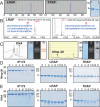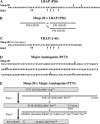Mmp-20 and Klk4 cleavage site preferences for amelogenin sequences
- PMID: 19767579
- PMCID: PMC2751868
- DOI: 10.1177/0022034509342694
Mmp-20 and Klk4 cleavage site preferences for amelogenin sequences
Abstract
Mmp-20 and Klk4 are the two key enamel proteases. Can both enzymes process amelogenin to generate the major cleavage products that accumulate during the secretory stage of amelogenesis? We isolated Mmp-20 and Klk4 from developing pig teeth and used them to digest the tyrosine-rich amelogenin polypeptide (TRAP), the leucine-rich amelogenin protein (LRAP), and 5 fluorescence peptides. We characterized the digestion products by LC-MSMS, SDS-PAGE, and C18 RP-HPLC monitored with fluorescence and UV detectors. Mmp-20 cleaves amelogenin sequences after Pro(162), Ser(148), His(62), Ala(63), and Trp(45). These cleavages generate all of the major cleavage products that accumulate in porcine secretory-stage enamel: the 23-kDa, 20-kDa, 13-kDa, 11-kDa, and 6-kDa (TRAP) amelogenins. Mmp-20 cleaves LRAP after Pro(45) and Pro(40), producing the two LRAP products previously identified in tooth extracts. Among these key cleavage sites, Klk4 was able to cleave only after His(62). We propose that Mmp-20 alone processes amelogenin during the secretory stage.
Conflict of interest statement
All authors declare that there are no conflicting interests.
Figures




Similar articles
-
How do enamelysin and kallikrein 4 process the 32-kDa enamelin?Eur J Oral Sci. 2006 May;114 Suppl 1:45-51; discussion 93-5, 379-80. doi: 10.1111/j.1600-0722.2006.00281.x. Eur J Oral Sci. 2006. PMID: 16674662
-
Cleavage site specificity of MMP-20 for secretory-stage ameloblastin.J Dent Res. 2010 Aug;89(8):785-90. doi: 10.1177/0022034510366903. Epub 2010 Apr 16. J Dent Res. 2010. PMID: 20400724 Free PMC article.
-
Assessment of enamelysin (MMP-20) selectivity to three peptide bonds on amelogenin sequence.J Dent Res. 2002 Oct;81(10):664-7. doi: 10.1177/154405910208101002. J Dent Res. 2002. PMID: 12351662
-
Functions of KLK4 and MMP-20 in dental enamel formation.Biol Chem. 2008 Jun;389(6):695-700. doi: 10.1515/BC.2008.080. Biol Chem. 2008. PMID: 18627287 Free PMC article. Review.
-
Proteinases in developing dental enamel.Crit Rev Oral Biol Med. 1999;10(4):425-41. doi: 10.1177/10454411990100040101. Crit Rev Oral Biol Med. 1999. PMID: 10634581 Review.
Cited by
-
SM50 repeat-polypeptides self-assemble into discrete matrix subunits and promote appositional calcium carbonate crystal growth during sea urchin tooth biomineralization.Ann Anat. 2016 Jan;203:38-46. doi: 10.1016/j.aanat.2015.06.004. Epub 2015 Jul 6. Ann Anat. 2016. PMID: 26194158 Free PMC article.
-
Matrix metalloproteinase-20 over-expression is detrimental to enamel development: a Mus musculus model.PLoS One. 2014 Jan 23;9(1):e86774. doi: 10.1371/journal.pone.0086774. eCollection 2014. PLoS One. 2014. PMID: 24466234 Free PMC article.
-
Why does enamel in Klk4-null mice break above the dentino-enamel junction?Cells Tissues Organs. 2011;194(2-4):211-5. doi: 10.1159/000324260. Epub 2011 May 6. Cells Tissues Organs. 2011. PMID: 21546759 Free PMC article.
-
Enamel proteins and proteases in Mmp20 and Klk4 null and double-null mice.Eur J Oral Sci. 2011 Dec;119 Suppl 1(Suppl 1):206-16. doi: 10.1111/j.1600-0722.2011.00866.x. Eur J Oral Sci. 2011. PMID: 22243248 Free PMC article.
-
The proteolytic processing of amelogenin by enamel matrix metalloproteinase (MMP-20) is controlled by mineral ions.Biochim Biophys Acta. 2013 Mar;1830(3):2600-7. doi: 10.1016/j.bbagen.2012.11.021. Biochim Biophys Acta. 2013. PMID: 23201201 Free PMC article.
References
-
- Bartlett JD, Simmer JP. (1999). Proteinases in developing dental enamel. Crit Rev Oral Biol Med 10:425-441 - PubMed
-
- Bartlett JD, Simmer JP, Xue J, Margolis HC, Moreno EC. (1996). Molecular cloning and mRNA tissue distribution of a novel matrix metalloproteinase isolated from porcine enamel organ. Gene 183:123-128 - PubMed
-
- Bègue-Kirn C, Krebsbach PH, Bartlett JD, Butler WT. (1998). Dentin sialoprotein, dentin phosphoprotein, enamelysin and ameloblastin: tooth-specific molecules that are distinctively expressed during murine dental differentiation. Eur J Oral Sci 106:963-970 - PubMed
-
- Caterina JJ, Skobe Z, Shi J, Ding Y, Simmer JP, Birkedal-Hansen H, et al. (2002). Enamelysin (matrix metalloproteinase 20)-deficient mice display an amelogenesis imperfecta phenotype. J Biol Chem 277:49598-49604 - PubMed
-
- Daculsi G, Kerebel B. (1978). High-resolution electron microscope study of human enamel crystallites: size, shape, and growth. J Ultrastruct Res 65:163-172 - PubMed
Publication types
MeSH terms
Substances
Grants and funding
LinkOut - more resources
Full Text Sources

